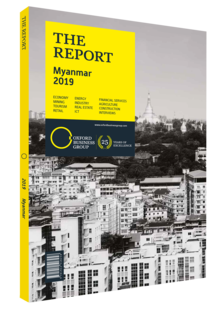China-Myanmar cooperation supports transport and logistics networks
Myanmar is considered a crucial component of China’s Belt and Road Initiative (BRI), the multibillion-dollar project that has the potential to shake up global trade and improve transnational infrastructure links. Of particular interest to China is a planned special economic zone (SEZ) and deepwater port at Kyaukphyu in Rakhine State, which would give Beijing direct access to the Indian Ocean, and therefore the Middle East and Africa beyond. The economic and political reforms that Myanmar began in 2011 were interpreted by some observers as an attempt to counter China’s growing control in the region, but the two remain crucial allies, with China still Myanmar’s biggest trading partner and largest source of foreign direct investment.
CMEC
Key to the BRI is the China-Myanmar Economic Corridor (CMEC). A memorandum of understanding on the CMEC was signed between the two countries in September 2018. While many of the finer details were not in the public domain as of December 2018, the broad aim of the project is to connect China’s Yunnan province to Mandalay, Kyaukphyu and Yangon through new roads and a high-speed railway. Investments required for the CMEC have been estimated at tens of billions of dollars.
The CMEC will also likely involve initiatives such as trade quotas, tax breaks and industrial zones to enhance economic cooperation. The two countries plan to work together in areas such as infrastructure, construction, manufacturing, agriculture, public health, water technology, tourism and finance. The CMEC also aims to prioritise five mega-projects: New Yangon City; Yangon-Ayeyarwady Development project and Pathein Industrial Park; New Mandalay Resort City; Myotha Industrial Park in Mandalay; and a central business district in Muse, near the Chinese border.
The strengthening of transport networks to the Chinese border could result in significant opportunities for Myanmar’s logistics and transport sectors. Although the details of the CMEC remain relatively abstract, China’s determination to press ahead with the BRI, coupled with Myanmar’s desire to boost connections with its neighbours, means that many of the projects outlined under the scheme will likely go ahead, at least in some form.
Prospects are also likely to be strengthened by China’s support for Myanmar over its handling of the unrest in Rakhine State. In contrast to many Western countries, China has continuously argued that the unrest is an internal issue, and has also provided Myanmar with protection at the UN Security Council.
Being Cautious
Given the fiscal constraints the Myanmar government faces, it is important that it negotiates deals that are in the best possible interest of the country and does not leave it overburdened with unsustainable debt. With that in mind, the renegotiations around the Kyaukphyu SEZ make for an interesting development. In August 2018 the media reported that the cost of the project had been scaled back from $7.3bn to $1.3bn. At the same time, the ownership stake of China’s state-owned CITIC group was reduced from 85% to 70%, with the remainder being allocated to the Myanmar government and local firms. The changes followed concerns from Myanmar about the size of the debt it would incur, with officials citing the experience of Sri Lanka, whose government engaged in a debt-for-equity swap with China in Hambantota Port, signing it over to Chinese interests on a 99-year lease in order to pay off loans used to finance the project. China insists it has no interest in exporting its “social system and development model” to other countries.
Despite the obvious economic benefits the CMEC can bring Myanmar, a legacy of projects conducted in the past without transparency – many of them backed by Chinese firms – means that segments of the public remain sceptical. Continued public anger against the China-backed Myitsone Dam project in Kachin State, which was suspended in 2011, is one example of this. Critics have said that negotiations related to CMEC have so far lacked transparency, and that negotiations should take into account local residents’ concerns.
You have reached the limit of premium articles you can view for free.
Choose from the options below to purchase print or digital editions of our Reports. You can also purchase a website subscription giving you unlimited access to all of our Reports online for 12 months.
If you have already purchased this Report or have a website subscription, please login to continue.

